#Egyptian pottery
Text

Lotiform Chalice
Third Intermediate Period
Ca. 945–664 B.C.
From Middle Egypt, Tuna el-Gebel region; From Egypt.
The fragrant blossom of the blue lotus is a common motif in all forms of Egyptian art. Because it opened its petals to the sun each morning, the flower became a symbol of creation and rebirth. During the Third Intermediate Period, faience chalices derived from the shape of the blossom and other faience delicacies were decorated with relief scenes evoking a constellation of myths having to do with the birth of the king as child of the sun god out of the watery marsh environment, and thus the renewal of the world out of the flooded land anticipated with the beginning of the Inundation at the Egyptian New Year.
#Lotiform Chalice#Ca. 945–664 B.C.#Third Intermediate Period#blue#blue lotus#pottery#Egyptian pottery#ancient pottery#ancient artifacts#archeology#archeolgst#history#history news#ancient history#ancient culture#ancient civilizations#ancient egypt#egyptian history#egyptian art
800 notes
·
View notes
Text
In Luxor, Egypt, a handful of dedicated craftsmen are fighting to keep the age-old tradition of hieroglyph carving alive. This is their fascinating story.
#ancient languages#ancient Egypt#hieroglyphs#Egyptian pottery#Egyptian traditions#Luxor#ancient#history#ancient origins
23 notes
·
View notes
Text

BOATS ON THE RIVER
Naqada Il (late), c. 4000-3000 BC
“Small shouldered jar with horizontal barrel lug, handles for suspension, Fine marl A, variant 4, light brown (7.5 YR 6/4). Handmade (probably coil-built) in two parts, joined at top of shoulder. Ledge rim and lugs applied. Exterior covered with self slip, then weak red (2.5 YR 4/2) painted decoration applied with brush: two boats with 20 oars,two cabins, harpoon standard and double branch in bow, trees and birds on the river bank. Double wavy lines around top of rim.”
9 notes
·
View notes
Text

~ Pottery bowl containing paint, once belonging to a fresco painter.
Period: Roman
Date: A.D. 1st century
Place oforigin: Egypt
#ancient#ancient art#history#museum#archeology#roman#ancient history#archaeology#ancient Egypt#egyptology#Egyptian#Egypt#paint#pottery#pottery bowl#1st century
11K notes
·
View notes
Text

Ancient Egyptian hippo & hedgehog squad at the Brooklyn Museum!
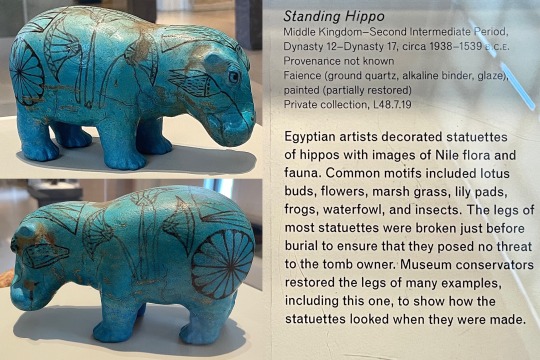
Standing Hippo
Middle Kingdom 2nd Int. Per. Dyn.12-17 c1938-1539BCE
Faience
“Egyptian artists decorated statuettes of hippos with images of Nile flora & fauna. Common motifs included lotus buds, flowers, marsh grass, lily pads, frogs, waterfowl, & insects. The legs of most statuettes were broken just before burial to ensure that they posed no threat to the tomb owner. Museum conservators restored the legs of many examples, including this one, to show how the statuettes looked when they were made.”
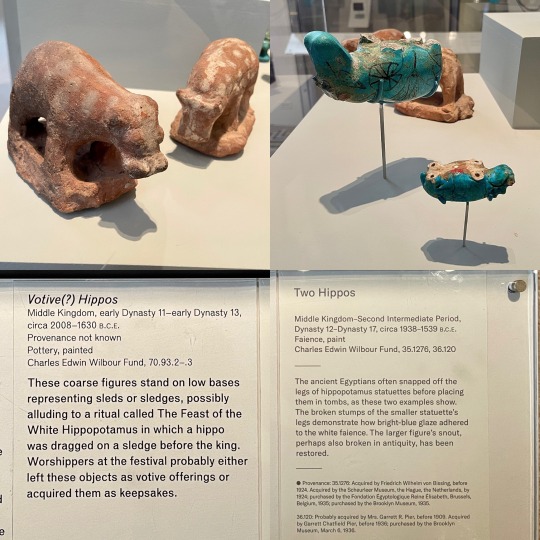
L: Votive(?) Hippos
Middle Kingdom Dyn.11-13 c2008-1630BCE
Painted pottery
“These coarse figures stand on low bases representing sleds or sledges, possibly alluding to a ritual called The Feast of the White Hippo in which a hippo was dragged on a sledge before the king. Worshippers at the festival probably either left these objects as votive offerings or acquired them as keepsakes.”
R: Two Hippos
Middle Kingdom Dyn.12-17 c1938-1539BCE
“The ancient Egyptians often snapped off the legs of hippopotamus statuettes before placing them in tombs, as these two examples show. The broken stumps of the smaller statuette's legs demonstrate how bright-blue glaze adhered to the white faience. The larger figure's snout, perhaps also broken in antiquity, has been restored.”
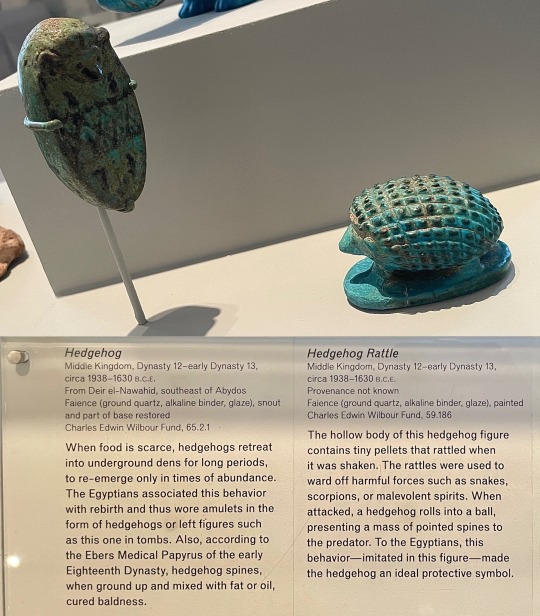
L. Hedgehog Rattle
Middle Kingdom Dyn. 12-13 c1938-1630BCE
Faience, 7.6 x 4.4 x 3.5 cm
“The hollow body of this hedgehog figure contains tiny pellets that rattled when it was shaken. The rattles were used to ward off harmful forces such as snakes, scorpions, or malevolent spirits. When attacked, a hedgehog rolls into a ball, presenting a mass of pointed spines to the predator. To the Egyptians, this behavior-_imitated in this figure-made the hedgehog an ideal protective symbol.”
R. Hedgehog Figurine
Middle Kingdom Dyn. 12-13 c1938-1630BCE
Faience, 4.2 x 4.1 x 7.1 cm
“When food is scarce, hedgehogs retreat into underground dens for long periods, to re-emerge only in times of abundance.
The Egyptians associated this behavior with rebirth and thus wore amulets in the form of hedgehogs or left figures such as this one in tombs. Also, according to the Ebers Medical Papyrus of the early Eighteenth Dynasty, hedgehog spines, when ground up and mixed with fat or oil, cured baldness.”
(note: labels are reversed - rattle is on L & figurine on R)
#animals in art#ancient art#Egyptian art#Ancient Egyptian art#Ancient Egypt#Brooklyn Museum#museum visit#hippo#hippos#hippopotamus#hippopotamuses#hedgehog#hedgehogs#pair#ceramics#pottery#faience#funerary art#votive#figurine#rattle
116 notes
·
View notes
Text

Polychrome vase, Egypt, 18th Dynasty, circa 1500-1292 BC
from The Egyptian Museum, Cairo
100 notes
·
View notes
Text
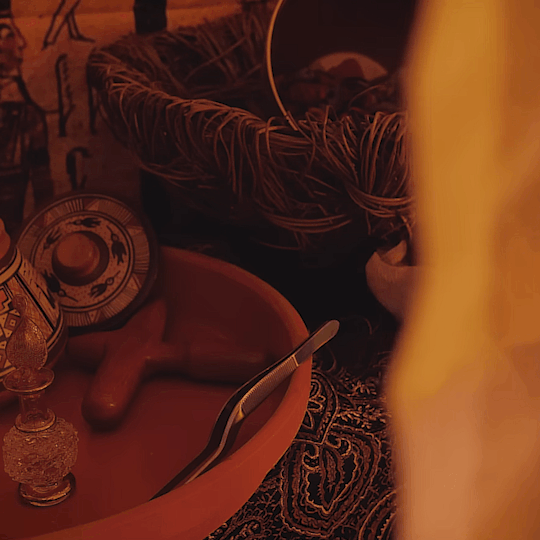



( x )
#stim#visual stim#stim gifset#mine#no hands#slow#egyptian#ancient egypt#orange#brown#pottery#art#potions
43 notes
·
View notes
Text

Happy ArtMonday!
Today I can finally show this artwork ^^
It is a revisited piece, reborn from an original drawing I made 15 years ago
In the heart of Edinburgh lies a haven of secrets, guarded by three sisters, in a world teeming with darkness and mysteries.
In this meticulously artwork, the youngest sister, Rina, stands amidst a labyrinth of knowledge, her sanctuary against the creatures of the night. But she is more than a mere guardian of books—she is a keeper of secrets, a seeker of truth, and a sentinel against the shadows.
Painted with over 170 hours of painstaking detail and imbued with rich symbolism, 'The Lorewarden' is a true labor of love and dedication. Two full days were devoted solely to labeling the 250 intricately detailed books of this extraordinary library. From real tomes to fictional volumes, each book adds depth and intrigue to Rina's quest for knowledge.
Crafted with unwavering determination, this illustration captures the essence of a universe where darkness lurks just beyond the veil of ignorance.
Enter the realm of "The Lorewarden" and join Rina on her quest to uncover the truths hidden within those countless pages. Here, magic, myth, and mystery collide and every word holds a secret waiting to be unveiled.
Are you ready to lose yourself in the exploration of these shelves, discovering which books are fictional and which are not?
Story/Universe is © @valkblue, Character is © both of us.
Software used: Clip Studio Paint.
#isilrinart#my ocs#fanart#redraw#books#knowledge is power#antiquity#greek mythology#norse mythology#egyptian mythology#mysticism#norse gods#egyptian gods#red-figure pottery#Ancient Greek painted pottery style#vegvisir#magic#redhead beauty#LKL#RinaLKL
6 notes
·
View notes
Text
Vintage Ceramic Wall Masks by Clay Art of San Francisco Co.

Saturn 🪐 ⭐️

Song of the Sea 🎶🌊🐟

Cheetah mask 🐆
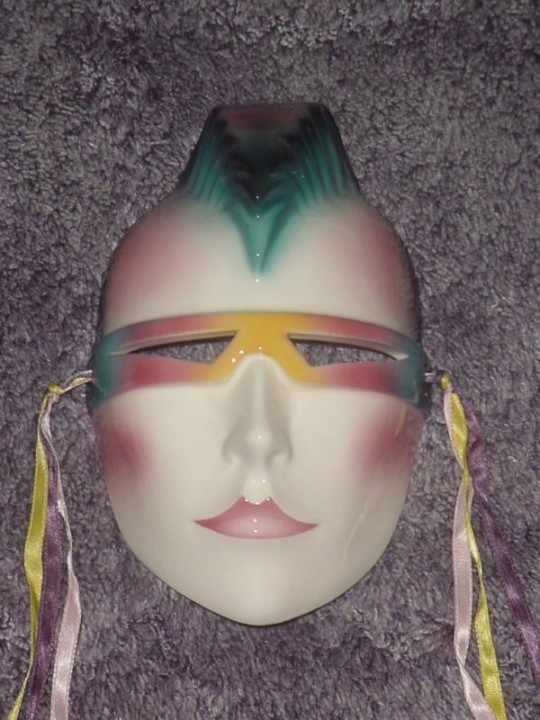
Spike - Blue Green 🧷 💙💚💕💛💜
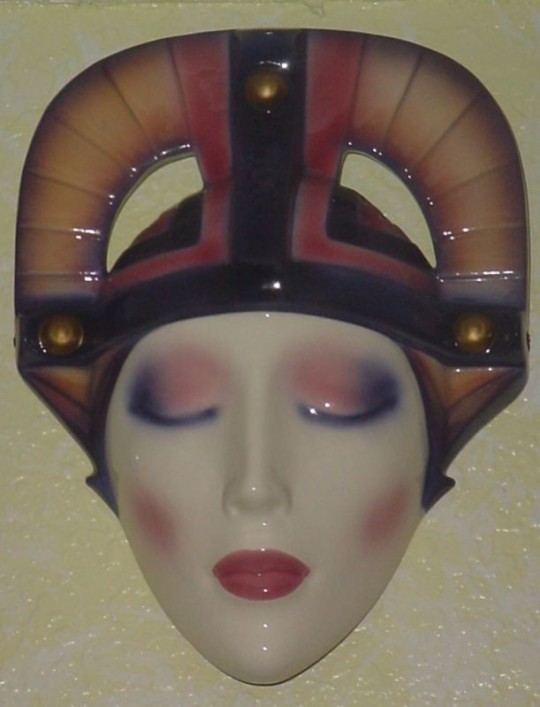
Isis 💜💓

Star 🌟 Magic 🌙
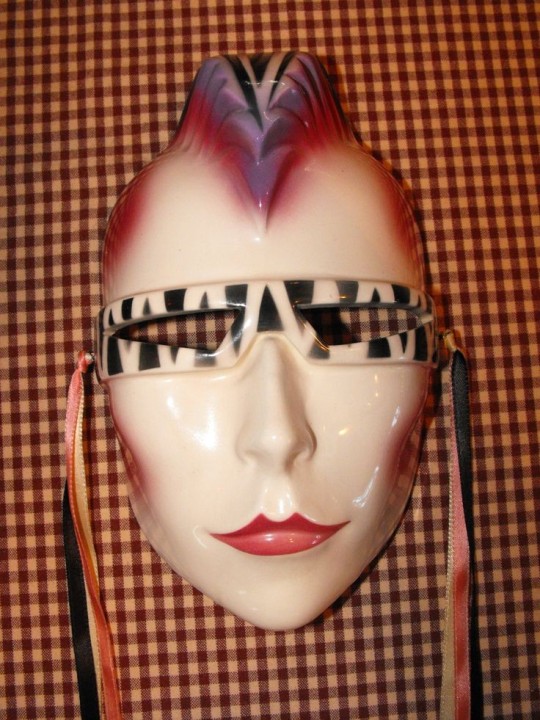
Spike - Purple Pink 🧷 💜 💓

Señorita Flamencio Dancer Mask 🇪🇸❤️

New Romantic/Blitz Kids Mask 💜🤍
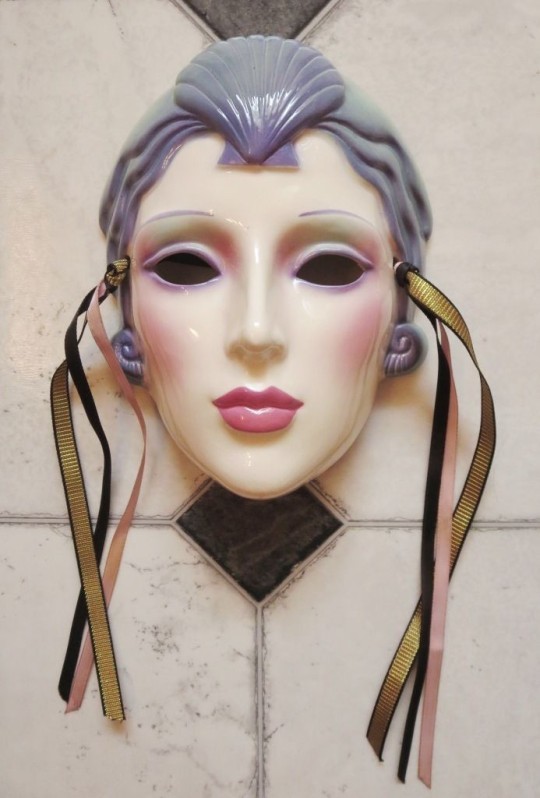
Seashell 🐚 Mask.
#all pinterest finds#vintage ceramics#vintage ceramic wall masks#Clay Art of San Francisco Co.#1980s#80s#80s art#pottery face#sci fi#fantasy#punk#mohawk#fish#ocean#sea#stars#planets#saturn#cheetahs#egyptian mythology#Señorita#flamenco#new romantics#blitz kids#seashells
7 notes
·
View notes
Text
I had. A hell of a time getting home. And the first thing I notice when I open this app is the fucking Tumblr live
#I have a fun two truths and a lie now#I have been stuck in an elevator. I dropped a 3000 year old sherd of Egyptian pottery. I had a missing person alert filed for me for an hour
7 notes
·
View notes
Text
The Apries Amphora

Amphora with cartouche
Cartouches with hieroglyphs spelling out Wahibre and Haaibre, the names of Apries, encircle the neck. Below two boxers face each other over a cauldron. The cartouches and the boxers loin cloths are Egyptian features, but the shape and style of the vase are Greek.
It was probably made to order in Ionia for a customer in Egypt.
Made in north Ionia, about 550 BC. Found in Thebes, Egypt.
On loan from the collection of Herbert Cahn (HC1175) and the Petrie Museum (UC30035-ab)
British Museum
Source: https://www.flickr.com/photos/24729615@N00/7689958022

Detail of the Apries Amphora with the cartouches of Apries
Source: https://www.flickr.com/photos/antiquitiesproject/21222466542
Very interesting artifact! But I think that the production date for this amphora is perhaps some decades earlier than the date given above, because by 550 BCE ordering an amphora with the cartouches of Apries would be rather dangerous for an Egyptian: Apries, who had ascended the throne in 589 BCE, was overthrown in 570 BCE by a revolt of his Egyptian troops led by general Amasis and, according to contemporary Egyptian sources, he was killed in 567 BCE during an attempt to reclaim the throne with Babylonian help. Afterward Amasis ruled unperturbed as Pharaoh till his death in 526 BCE. It is difficult for me to imagine that even an Apries loyalist would dare to defy openly Amasis’ power by ordering and possessing an amphora with the cartouches of Apries that Amasis had overthrown and killed, given also that most Egyptians disliked, as it seems, Apries. The fall and death of Apries as a result of a revolt of the Egyptian troops and the rise of Amasis to the throne are narrated by Herodotus in Book II of Histories, although without mention of a Babylonian intervention in favor of Apries.
10 notes
·
View notes
Photo
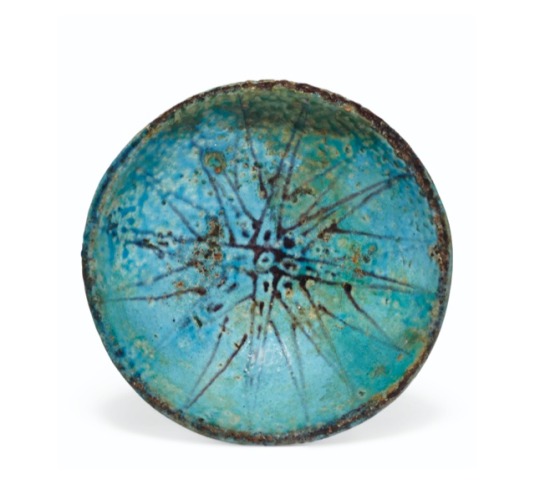
AN EGYPTIAN FAIENCE BOWL
NEW KINGDOM, 18TH DYNASTY, 1550-1295 B.C.
3 7/8 in. (9.8 cm.) diameter.
#AN EGYPTIAN FAIENCE BOWL#NEW KINGDOM 18TH DYNASTY 1550-1295 B.C.#pottery#egyptian pottery#ancient pottery#ancient artifacts#archeology#archeolgst#history#history news#ancient history#ancient culture#ancient civilizations#ancient egypt#egyptian history#egyptian art#blue
40 notes
·
View notes
Text
Here's a project that I done in pottery and yes I'm in there again since I didn't take the first semester and my teacher was fine with it. My project is to do an ancient timeline and must do two artworks in different times. Since I didn't have enough time to do my second ancient work, I got to do a ancient Egypt organ jar. I made Taweret from moon kight cause she's pretty and I carved hieroglyphs into my jar.
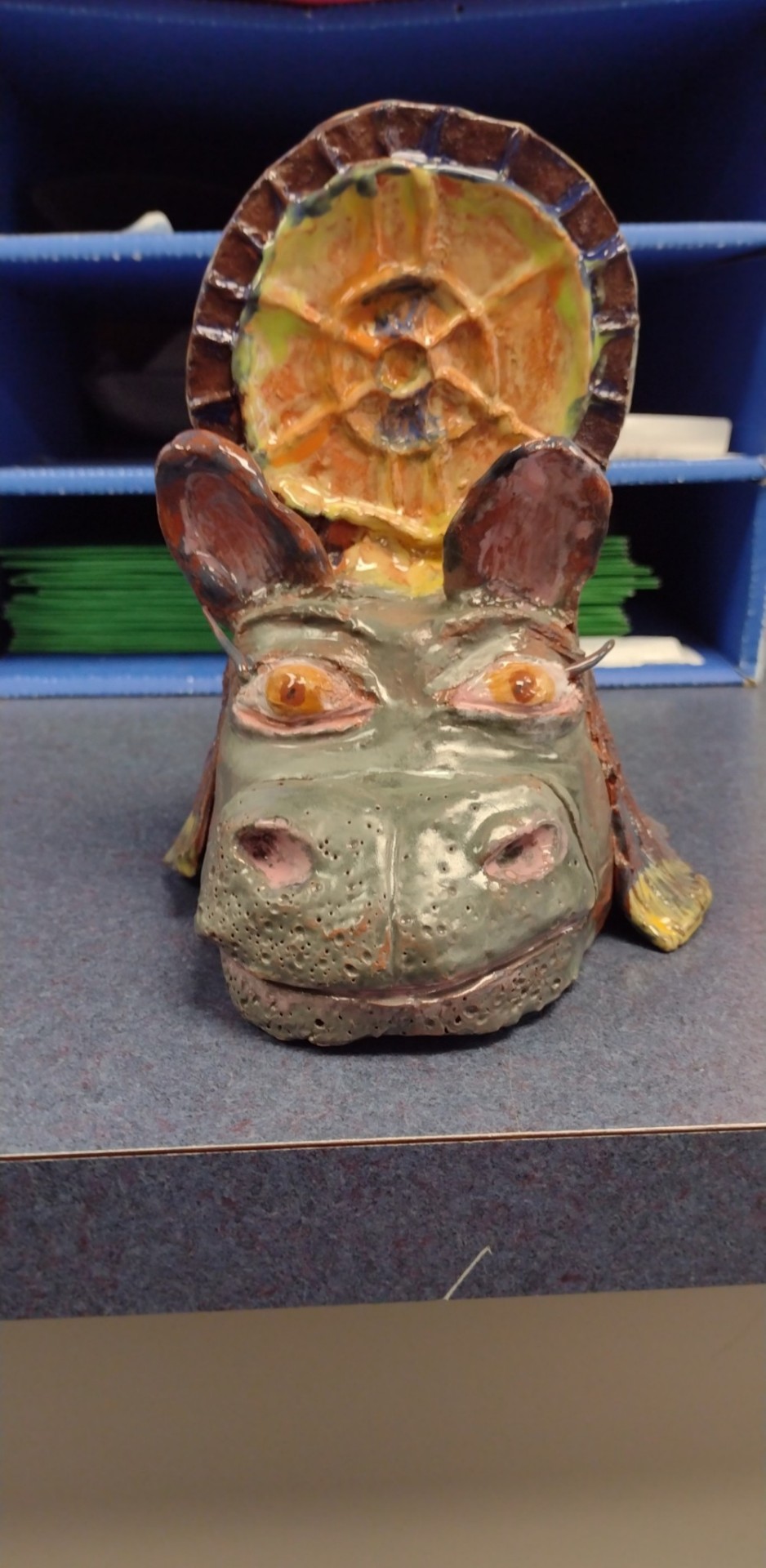
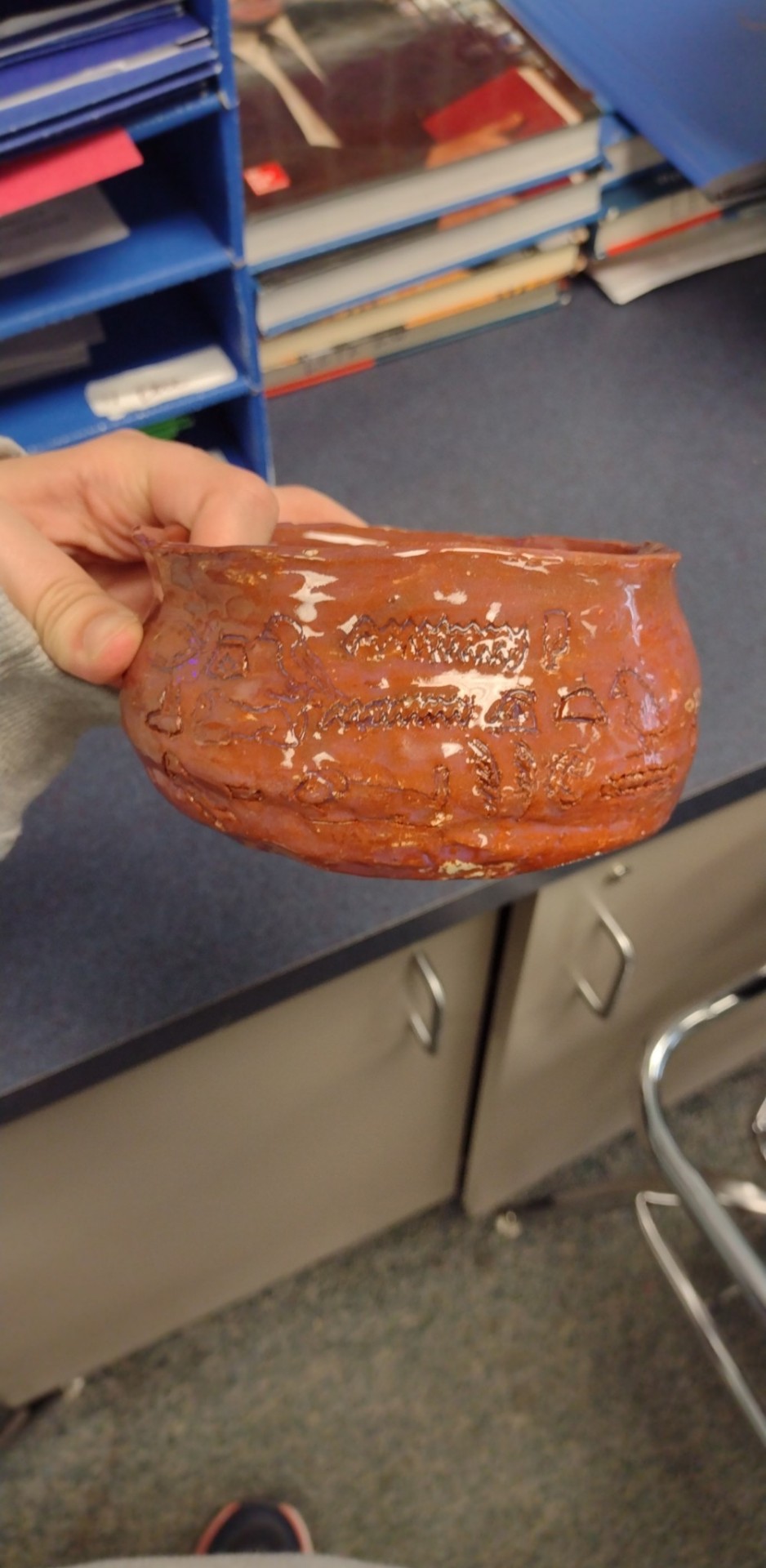
5 notes
·
View notes
Text

Polychrome-decorated, handled vessels, fine marl clay, tomb of Kha; Deir el-Medina,
late Eighteenth Dynasty. (Courtesy of Il Museo delle Antichita Egilze, Turin)
10 notes
·
View notes
Text

~ Vessel.
Place of origin: Egypt
Period: 18th Dynasty, New Kingdom
Date: ca. 1539-1295 B.C.
Medium: Glass
#ancient#ancient art#ancient pottery#pottery#ancient Egypt#Egypt#Egyptian#vessel#18th Dynasty#new kingdom#glass#ca. 1539 b.c.#ca. 1295 b.c.#history#archeology#museum
395 notes
·
View notes
Text

Canopic jar for the lidded vessel assignment 
0 notes